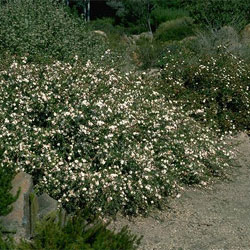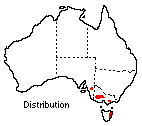Philotheca verrucosa
 normal flowers |
 multi-petalled flower of Philotheca 'J.Semmens' |
 plant of Philotheca 'J.Semmens' |
Previously known as Eriostemon verrucosus
Fairy Waxflower or Bendigo Waxflower
Philotheca verrucosa (A.Rich.) Paul G.Wilson
The genus Philotheca includes some of the most attractive and most adaptable Australian plants in cultivation. This group of plants belongs to the family Rutaceae (which includes the citrus fruit trees). There are fifty-one taxa (species and sub-species) of Philotheca some of which were previously classified as species of Eriostemon. All have aromatic leaves.
 Philotheca
verrucosa is commonly called Fairy Waxflower or Bendigo Waxflower and has
often been confused with P. obovalis. Confined to the Blue Mountains
area near Sydney, P. obovalis has branchlets which are less warty than
those of P. verrucosa and smaller, solitary flowers. P. verrucosa occurs naturally on poor stony ground and on dry hills in Victoria, South Australia
and Tasmania. It is generally a small sprawling or upright shrub to 1.2 m often
with arching branches. However, it has been recorded as growing to 2 m high
in the Gippsland area of Victoria.
Philotheca
verrucosa is commonly called Fairy Waxflower or Bendigo Waxflower and has
often been confused with P. obovalis. Confined to the Blue Mountains
area near Sydney, P. obovalis has branchlets which are less warty than
those of P. verrucosa and smaller, solitary flowers. P. verrucosa occurs naturally on poor stony ground and on dry hills in Victoria, South Australia
and Tasmania. It is generally a small sprawling or upright shrub to 1.2 m often
with arching branches. However, it has been recorded as growing to 2 m high
in the Gippsland area of Victoria.
The branchlets of P. verrucosa have prominent glands, which give them a warty appearance. The aromatic leaves which are arranged alternately along the stems are smooth above and warty beneath and 6-15 mm long. The dainty white flowers are tinged with pink and produced at the end of the branches or in the leaf axils. The 5 petals are arranged in star-like fashion and the ten stamens enclose the pistil. The fruit consists of 5 segments, each containing one or two shiny black seeds which are ejected when the fruit ripens and splits open.
Difficulty has been experienced in germinating seeds. P. verrucosa can be propagated from half-hardened tip cuttings taken in March/April. The strike rate is very variable; some produce roots quickly whilst others can remain static for some time. Better results have been achieved by removal of the growing tip from cutting material. Use of a rooting hormone may be advisable.
P. verrucosa is frost hardy and reasonably drought tolerant. In cultivation it grows best in well drained soil in a dry, sunny or semi-shaded position. Several double or multi-petalled forms of P. verrucosa have been found but the only one which has been registered as a cultivar is Philotheca 'J. Semmens' which has three layers of petals surrounding the stamens and ovary. This cultivar was found first on the property of the late J. Semmens in 1910. It grows to a height of 0.6 m by 0.6 m across and is often sparsely foliaged. This plant must be propagated by cuttings if its form is to be retained.
Text by Effie Mullins, ANBG (1989)
Name meaning: Philotheca verrucosaPhilotheca - from two Greek words meaning 'naked' and 'covering' or 'box', apparently referring to the way the stamens are fused at the base into a glabrous tube, verrucosa - from Latin, 'covered with warts'. |
![An Australian Government Initiative [logo]](/images/austgovt_brown_90px.gif)

